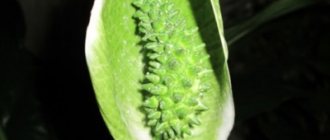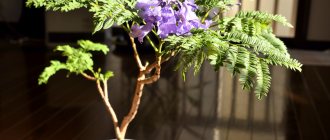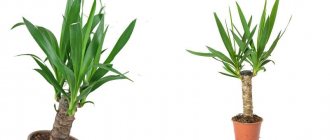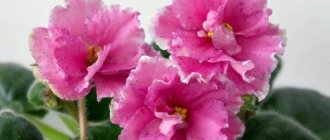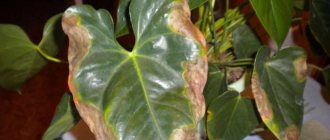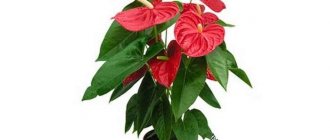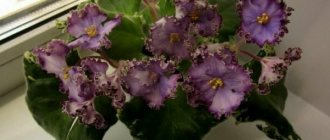- January 9, 2019
- Flowers
- Efimova Anastasia
The anthurium plant is considered one of the most unusual and exotic to keep at home. This representative of the plant world came to us from the tropical zone of South America, which means that creating a suitable microclimate for it in an apartment is not so easy.
But flower growers are not afraid of difficulties, because this plant literally attracts the eye with its bright shiny foliage and extraordinary “waxy” flowers. It is for the shape of the bud that the anthurium got its name - from Greek it is translated as “flower-tail”. The inflorescence looks like a spadix, around which a bright cloak of red, white, green or deep burgundy is spread.
Anthurium picks up color well even at home: in cold periods there can be 3-4 flowers on a bush, in warm periods - up to 8-12. The fruits are juicy, fleshy berries. All parts of the plant are poisonous.
Novice gardeners often ask why anthurium blooms with small flowers. As a rule, this phenomenon is observed several years after purchase, and every year smaller and smaller inflorescences appear on the plant. So why do anthurium have small flowers? In order to answer this question, you must first find out how to properly care for the plant and in what conditions to keep it.
Popular types
There are several types of anthurium that are especially popular among home plant lovers, namely:
- Andre is an epiphytic (naturally grows on the bark of trees) plant with a short stem, bright heart-shaped foliage (white, all shades of green, burgundy or speckled). The most popular species for home breeding.
- Anthurium Scherzer. An epiphytic plant with dense green leaves up to 20 cm long of different shapes (depending on the specific variety). The peduncle grows from 15 cm to half a meter, the ear is spiral. The berries are orange-red.
- Baker's Anthurium. A low epiphyte with a short stem and belt-shaped narrow leaves up to half a meter long. The leaves are green on the front side, covered with reddish specks on the back. The inflorescence cover is leathery, light green, and small in size. Cob – up to 10 cm long. The berries are small, scarlet in color.
- Anthurium Hooker. An epiphytic plant with large green leaves with black speckles, growing in a rosette. The bedspread is narrow and green. Peduncle – 45-90 cm.
- Climbing. Epiphyte up to 90 cm tall with bright leathery oval leaves. There are black spots on the inside of the leaf. The peduncle is small, up to 6 cm, green or red. The blanket is green, up to 15 cm long. The color of the fruit depends on the variety.
- Multi-dissected. This is a vine with palmately dissected leaves with wavy edges. The peduncle often reaches 25 cm in length. The berries are red.
- Crystal. A plant with large, broad, heart-shaped leaves, velvety and with a white vein on the front side. The peduncle is up to half a meter, the cob is usually half that size.
Now, to answer the question why anthurium has small flowers, you need to find out how to properly maintain it.
Watering
Watering needs to be balanced, without waterlogging or drying out the soil. The first is much more dangerous, since the roots will rot. Therefore, it is important to always drain the water remaining in the pan.
In summer you need to water the flower every three days; in winter it is recommended to moisten the soil once a week. But this may not be enough, since in winter apartments are often hot and dry, and the soil dries out quickly.
Optimal air humidity is 70%. Therefore, you need to spray the flower regularly, and also wipe the leaves with a damp cloth.
Anthurium does not like lime water - it can react to it by yellowing the leaves. Therefore, for irrigation it is necessary to use clean melted or filtered lukewarm water.
Causes of poor growth
The lack of development or its slow pace, as well as the impossibility of flowering, are associated with a number of reasons:
- improper lighting;
- inappropriate temperature – the flower does not like excess heat or cold;
- watering should also be at the proper level;
- the size of the pot does not correspond to the size of the anthurium root system;
- Inappropriate soil was selected for planting;
- there are not enough nutrients in the soil or fertilizing is carried out irregularly;
- the plant was transplanted in violation of the rules;
- the pot is often moved from place to place;
- the flower is in a draft;
- insufficient air humidity in the room;
- the presence of a large number of wilted buds on the plant;
- presence of pests or disease.
Next, we will describe in detail the most common causes and methods for eliminating them. By adhering to optimal growing conditions for anthurium, it will be possible to resume its growth and achieve flowering.
Soils and fertilizers
Why do anthurium have small flowers? Care plays an important role, and here the correct choice of substrate for planting and regular feeding should not be underestimated. The soil for the plant must be loose and with good drainage. Soil mixtures intended for orchids are well suited for anthurium. You can also use soil made from deciduous soil, peat and sand with pieces of pine bark.
Fertilizing is applied only during periods of intensive growth, that is, in winter and summer. Frequency – once every two weeks. You can use both mineral complexes (in the form of solutions) and organic fertilizers, such as chicken manure.
Transfer
Inexperienced flower growers can come up with their own answer to the question of why anthurium has small flowers. Some of them think that this is due to incorrect or untimely transplantation. In fact, this is rarely true. Due to mistakes during replanting, the plant may turn yellow, fail to gain color, and even die. Whereas anthurium often has small leaves and flowers for other reasons.
The plant still needs to be replanted: after purchase - after 10 days, young specimens - annually, mature plants - once every three years.
Reproduction
The easiest way to propagate anthurium is by apical cuttings - they are rooted in damp sand and covered with film to create a greenhouse effect. Such plants need to be ventilated daily.
It is more difficult to propagate a flower by dividing a bush, as the roots can easily be damaged. However, this is many times easier than trying to grow anthurium from seeds.
To do this, cross-pollination is carried out during the flowering period, and the resulting fruit, after ripening, is removed with tweezers. Then it ripens for another 6-8 months, after which the seeds can be sown in loose soil and wait for sprouts.
So why do anthurium have small flowers? There are actually not many reasons, so you can find the source of the problem quite quickly.
Air temperature
The development of the flower is adversely affected by the high ambient temperature in winter, when the dormant period begins, and subsequently the formation of buds occurs. The plant responds well to moderate heat, but not heat. During the cold season, the room should not be warmer than 20 degrees.
When understanding why anthurium does not grow, it is necessary to take into account that from the end of autumn the flower enters a dormant period, which lasts for 3 months. The ideal temperature at this time will be 15-17 degrees. Moderate coolness will ensure the shoots with buds are thrown out.
When flower stalks begin to form (usually mid-February), the room temperature should be at 18-20 degrees. In summer, the flower normally tolerates a range of 20-25 degrees.
Malnutrition
There is another reason why anthurium has small flowers and leaves. The plant may gradually weaken due to a simple lack of nutrients. This happens due to a lack of fertilizing or due to soil depletion. What to do in such a situation?
The solution is obvious: you need to transplant the flower into a pot with fresh substrate. If this happens during the flowering period, or it is not yet time for the plant to move to a new apartment (according to the time intervals indicated above), then the anthurium must be replanted using the transshipment method. That is, choose a slightly larger container and move the plant into it without shaking the earthen ball. And pour fresh substrate on the sides and top. After a couple of weeks, the plant can be fertilized with mineral or organic fertilizers.
Other reasons
Sometimes it is possible to determine the reason why anthurium does not grow after measuring air humidity. The plant does not tolerate excessively dry air, so it should be sprayed several times a day with plain water. The leaves themselves can be wiped with a damp cloth - this will provide additional moisture and allow you to remove a layer of settled dust.
An incorrectly selected composition of purchased soil can also have a negative impact on plant growth. It is almost impossible to achieve flowering of anthurium if it is planted in a substrate suitable for the bromeliad families of flowering plants or cacti. A peat mixture will not work either. The soil should allow oxygen to pass through and be slightly acidified. A good option would be a mixture for orchids.
The presence of a large number of wilted buds on the bush takes away the plant’s strength, which is spent on forming seeds. The faded bud should be cut off with a sharp knife or scissors.
Natural aging
There is another option why anthurium has small flowers. The reason is the natural aging and gradual degeneration of an adult plant. Interestingly, mature specimens look different from different gardeners. For some it will be a lush and green bush with crushed inflorescences, for others the number of flowers will be reduced to 1-2.
But overall the picture will not be very happy. Anthurium will lose its exotic appearance, turn pale, and its stem will become bare. In the future it will simply stop blooming.
In this case, the plant needs to be healed and rejuvenated. The operation consists of removing the ground part so that a pair of aerial roots remain on the cutting. At the same time, the plant is replanted and a little growth stimulator is added for good rooting.
The young shoot must be kept at a temperature of +20-22⁰ and regularly sprayed with warm water.
Why is this happening?
One of the common causes of this problem is the natural aging of anthurium . During this period, the plant trunk becomes bare, and the flowers become small and pale. If you want to keep the plant looking beautiful, you need to carry out a rejuvenation procedure.
- Using pruning shears, cut off the top part of the anthurium with 2 or 3 aerial roots.
- Next, plant it in a separate pot with soil.
- The young plant needs to be sprayed, watered in a timely manner, and the average room temperature maintained at +200C.
The following is a detailed list of other reasons why anthurium flowers may be small and pale.
Fungus
This plant is extremely rarely affected by pests due to its toxicity. But the fungus often attacks anthurium. A problem arises due to non-compliance with care requirements. There are several of the most popular types of fungus that appear on anthurium.
- Fusarium. The flowers become pale and the foliage turns yellow. If no action is taken, the anthurium will die. The disease can also be detected by sideways curvature of the trunk and noticeable darkening at the base.
- Anthracnose. Appears at high humidity and temperature. The buds do not fit, the flowers lose their brightness. Gray spots with a yellow border appear on the leaves.
- Rust. One of the signs is small and pale inflorescences. The problem can also be diagnosed by light yellow marks on the top of the leaves and brown spots on the inside of the leaves.
Important! If you find a fungus, be sure to treat the entire bush with any of the available fungicides (Maxim, Topaz, Previkur, Trichodermin).
After treating the bush with a fungicide, the following measures should be taken:
- Remove all affected parts, and spray the green parts with a solution containing a growth stimulator (Epin, Zircon).
- Remove the anthurium from the pot and inspect the roots, removing all diseased parts.
- Sprinkle the sections with crushed activated carbon.
- If the size of the root system has decreased, transplant the anthurium into a smaller pot.
Pests
Pests rarely attack anthurium , but if the plant is damaged, it will be:
- scale insect;
- thrips;
- scale insects;
- aphid.
Aphids accumulate on young inflorescences and shoots. Thrips are dangerous because they multiply quickly. Scale insects are sucking insects. Larvae and adult females suck young shoots, leaves, and buds. One of the results of pest infestation is shredding and paleness of the inflorescences.
It is best to combat parasites with the help of special chemicals. These are Fitoverm, Actellik, Akarin, Karate, Iskra.
You can learn more about diseases and pests that can affect anthurium from special material.
Drafts
If the anthurium leaves curl and the flowers decrease in size, this is a sign that the plant is exposed to drafts. The pot needs to be moved to another place, but at the same time it is necessary to provide a constant flow of fresh air (so that the anthurium “breathes”).
Soil depletion
Anthurium flowers begin to shrink and fade when the soil is depleted.
To keep the plant healthy and pleasing to the eye with beautiful flowers, it is recommended to use a loose, moisture-proof substrate to create high-quality soil . Combine in it:
- peat;
- moss;
- turf land;
- or create a substrate from pine bark and sphagnum.
Improper watering
The appearance of small flowers can also be caused by improper watering. An excessive amount of moisture causes water to stagnate in the pot, the root rots, and this affects the condition of the entire plant. Dry soil causes the anthurium to wither and inflorescences not to form.
Lack of fertilizers
Anthurium requires fertilizer constantly, especially in the first years of life. In order for this plant to develop well, it is necessary to apply fertilizer regularly, preferably once every 3-4 weeks.
If there is a lack of fertilizer, the plant will not fully develop, which means the flowers will become small.
Excess fertilizer is also dangerous for anthurium. For example, the abundance of nitrogen in the soil causes excessive branching and lack of flowering.
Priming
To plant a plant, the soil must be slightly acidic, loose and saturated with useful substances . The roots will be provided with oxygen, and the anthurium will thank you with lush, bright flowers.
Reference! Peat is not suitable for a perennial plant, as it will stop the plant from blooming.
Hypothermia
Anthurium is sensitive to temperature changes. If there is a sharp drop or the plant gets hypothermia, it may be affected by rot or fungus. Therefore, it is necessary to control the temperature in the room where the anthurium grows; it must be at least +16 degrees.
Incorrect lighting
It is necessary to avoid direct sunlight on the plant , but there must be diffused lighting. If you place an anthurium in the sun, it may not bloom at all. In addition, burns will appear on the leaves and the flowers will be pale.
Other articles on the site will help you grow a beautiful and healthy plant, from which you can learn about the reasons why anthurium does not grow well, what to do if the flowers begin to turn green, as well as possible diseases of the leaves and what to do if they turn black or dry out.

